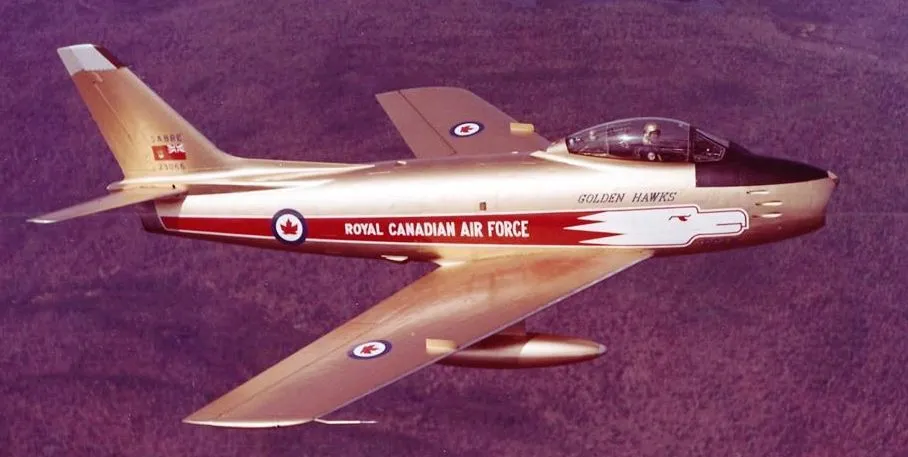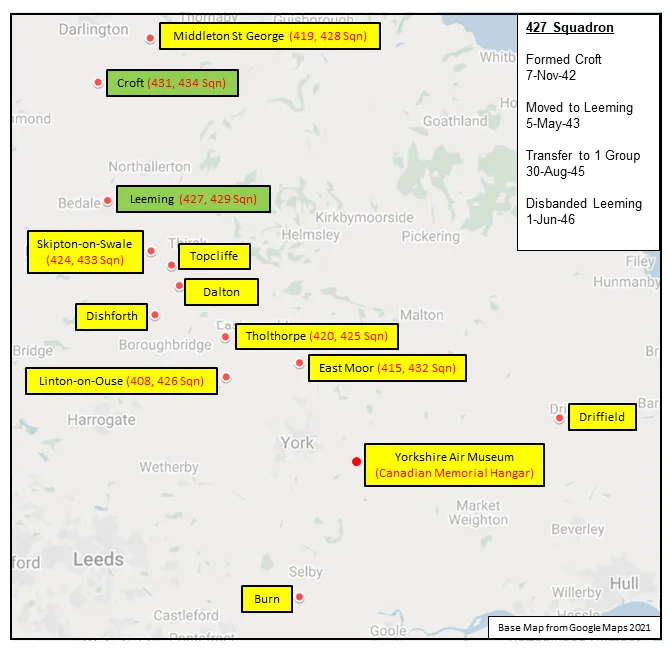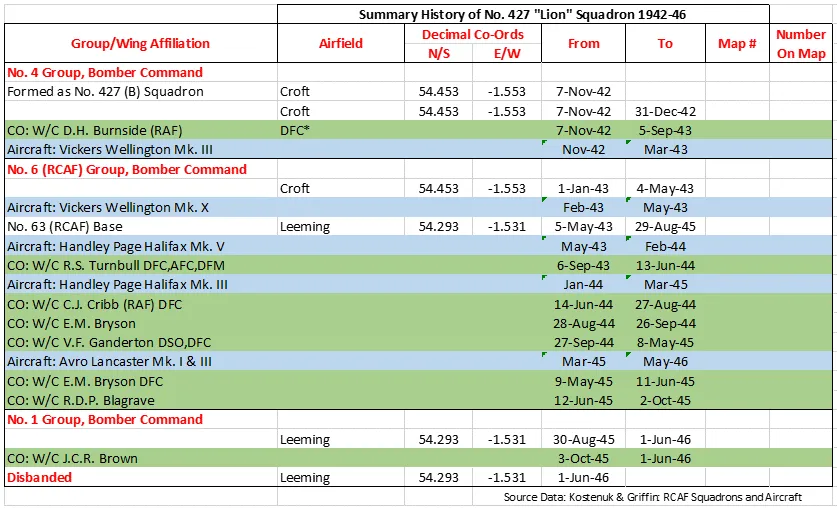Peterson, James Carl Pete (Flying Officer)
Killed in Flying Accident 1952-November-03


Birth Date: 1931-September-28
Born: Abbey, Saskatchewan
Parents: Son of Wilhelm and Mary Peterson of Shackleton, Saskatchewan. Brother of F/O Ronald (RCAF), John and Mary Peterson.
Spouse:
Home: Abbey, Saskatchewan
Enlistment: Medicine Hat, Saskatchewan
Enlistment Date: 1951-January-29
Service
RCAF
Unit
427 (F) Sqn- Squadron
Ferte Manus Certas Strike sure
Base
Rank
Flying Officer
Position
Pilot
Service Numbers
33113
Sabre serial: 19411

Canadair CL-13 Sabre Mk. 5 (Serial No. 23066), Golden Hawks
The North American F-86 Sabre, sometimes called the Sabrejet, is a transonic jet fighter aircraft. Produced by North American Aviation, the Sabre is best known as the United States' first swept-wing fighter that could counter the swept-wing Soviet MiG-15 in high-speed dogfights in the skies of the Korean War (1950"“1953), fighting some of the earliest jet-to-jet battles in history. Considered one of the best and most important fighter aircraft in that war, the F-86 is also rated highly in comparison with fighters of other eras. Although it was developed in the late 1940s and was outdated by the end of the 1950s, the Sabre proved versatile and adaptable and continued as a front-line fighter in numerous air forces.
Its success led to an extended production run of more than 7,800 aircraft between 1949 and 1956, in the United States, Japan, and Italy. In addition, 738 carrier-modified versions were purchased by the US Navy as FJ-2s and -3s. Variants were built in Canada and Australia. The Canadair Sabre added another 1,815 aircraft and the significantly redesigned CAC Sabre (sometimes known as the Avon Sabre or CAC CA-27), had a production run of 112. The Sabre is by far the most-produced Western jet fighter, with a total production of all variants at 9,860 units.
The fighter-bomber version (F-86H) could carry up to 2,000 lb (907 kg) of bombs, including an external fuel-type tank that could carry napalm. Unguided 2.75-inch (70-millimeter) rockets were used on some fighters on training missions, but 5-inch (127 mm) rockets were later carried on combat operations. The F-86 could also be fitted with a pair of external jettisonable jet fuel tanks (four on the F-86F beginning in 1953) that extended the range of the aircraft. Both the interceptor and fighter-bomber versions carried six 0.50 in (12.7 mm) M3 Browning machine guns with electrically-boosted feed in the nose (later versions of the F-86H carried four 20 mm (0.79 in) cannon instead of machine guns). Firing at a rate of 1,200 rounds per minute, the 0.50-inch guns were harmonized to converge at 1,000 ft (300 m) in front of the aircraft, using armor-piercing (AP) and armor-piercing incendiary (API) rounds, with one armor-piercing incendiary tracer (APIT) for every five AP or API rounds. The API rounds used during the Korean War contained magnesium, which were designed to ignite upon impact, but burned poorly above 35,000 ft (11,000 m) as oxygen levels were insufficient to sustain combustion at that height. Initial planes were fitted with the Mark 18 manual-ranging computing gun sight. The last 24 F-86A-5-Nas and F-86Es were equipped with the A-1CM gunsight-AN/APG-30 radar, which used radar to automatically compute a target's range, which later proved to be advantageous against MiG opponents over Korea. Wikipedia
![]() Wikipedia North American F-86 Sabre
Wikipedia North American F-86 Sabre
![]() YouTube F-86 Sabre Aerobatics - No Music! - Airshow London 2018
YouTube F-86 Sabre Aerobatics - No Music! - Airshow London 2018
F-86 (Canadair Sabre) Part Manual Volume I
F-86 (Canadair Sabre) Part Manual Volume II
F-86 (Canadair Sabre) Maintenance and Diagrams (Partial Document)
Unit Desciption
427 (F) Sqn Ferte Manus Certas ("Lion")
History of the Squadron during World War II (Aircraft: Wellington III, X, Halifax III, V, Lancaster I, III)

427 Squadron was the RCAF's 25th squadron and eighth bomber squadron to be formed overseas in WWII. It was formed at Croft, Yorkshire, England  on 7 November 1942 as part of No 4 Group of RAF Bomber Command. With squadron code letters ZL it flew Wellington Mk III aircraft. On 1 January 1943 it joined No 6 (RCAF) Group, remaining at Croft until May of 1943, when it moved to Leeming, Yorkshire
on 7 November 1942 as part of No 4 Group of RAF Bomber Command. With squadron code letters ZL it flew Wellington Mk III aircraft. On 1 January 1943 it joined No 6 (RCAF) Group, remaining at Croft until May of 1943, when it moved to Leeming, Yorkshire  , where it remained for the rest of the war in Europe. Its duties were to take part in strategic and tactical bomber operations. It briefly re-equipped with Vickers Wellington Mk X before acquiring Handley Page Halifax Mk V aircraft in May 1943. In January 1944 it re-equipped again with the improved Halifax Mk III. Finally it was equipped with Avro Lancaster Mks I and III in March 1945. After the termination of hostilities in Europe, the squadron remained in England and transferred to No 1 Group. It participated in operation EXODUS, the repatriation of POW's and operation DODGE, bringing back British troops from Italy. The squadron disbanded at Leeming on 1 June 1946.
, where it remained for the rest of the war in Europe. Its duties were to take part in strategic and tactical bomber operations. It briefly re-equipped with Vickers Wellington Mk X before acquiring Handley Page Halifax Mk V aircraft in May 1943. In January 1944 it re-equipped again with the improved Halifax Mk III. Finally it was equipped with Avro Lancaster Mks I and III in March 1945. After the termination of hostilities in Europe, the squadron remained in England and transferred to No 1 Group. It participated in operation EXODUS, the repatriation of POW's and operation DODGE, bringing back British troops from Italy. The squadron disbanded at Leeming on 1 June 1946.
In the course of WWII the squadron flew approximately 3300 operational sorties in the course of which either 88 (Moyes) or 90 (Kostenuk) aircraft were lost and approximately 10,300 tons of bombs were dropped. The squadron earned 4 DSO's, 147 DFC'c and 6 Bars to DFC, 1 AFC, 2 CGM's, 16 DFM's and 8 MiD. Battle Honours were: English Channel and North Sea 1943-45, Baltic 1944-45, Fortress Europe 1943-44, France and Germany 1944-45, Biscay Ports 1943-44, Ruhr 1943-45, Berlin 1943-44, German Ports 1943-45, Normandy 1944, Rhine, Biscay 1944. Wikipedia, Moyes, Kostenuk and Griffin
Squadron History (Bomber Command Museum PDF)
Maps for Movements of 427 Squadron 1942-46

427 Squadron History Summary 1942-46

History of the Squadron Post-WWII (Aircraft: Sabre 2, 5, 6, Starfighter, Kiowa, Twin Huey, Griffon)
The squadron was reactivated on 1 August 1952 as a fighter squadron in the Air Defence Command, based in St Hubert, Quebec  and equipped with Canadair F-86 Sabre Mk 2s. The Squadron moved on to Sabre Mks. 5 and 6 while working out of St Hubert before deploying to Zweibrücken, Germany
and equipped with Canadair F-86 Sabre Mk 2s. The Squadron moved on to Sabre Mks. 5 and 6 while working out of St Hubert before deploying to Zweibrücken, Germany  and becoming a part of 3 Wing, in March-April 1953. The Squadron continued in this role, operating out of Germany, for another decade, participating in many multi-national NATO exchanges and exercises with destinations including; Rabat, Morocco, Decimomannu, Sardinia and France. The squadron moved to Grostenquin, France
and becoming a part of 3 Wing, in March-April 1953. The Squadron continued in this role, operating out of Germany, for another decade, participating in many multi-national NATO exchanges and exercises with destinations including; Rabat, Morocco, Decimomannu, Sardinia and France. The squadron moved to Grostenquin, France  in June 1962, but was inactive pending its conversion to the CF-104 Starfighter. On 15 December 1962, the Squadron was deactivated as a Fighter squadron and reactivated on the 17th as a Strike/Attack squadron, becoming the first Canadian squadron to be equipped with the Starfighter. This change in aircraft necessitated changes in training and tactics. In 1969 the squadron moved from Zweibrücken to Baden-Soellingen
in June 1962, but was inactive pending its conversion to the CF-104 Starfighter. On 15 December 1962, the Squadron was deactivated as a Fighter squadron and reactivated on the 17th as a Strike/Attack squadron, becoming the first Canadian squadron to be equipped with the Starfighter. This change in aircraft necessitated changes in training and tactics. In 1969 the squadron moved from Zweibrücken to Baden-Soellingen  , and with that, a change from 3 Wing to 4 Wing.
, and with that, a change from 3 Wing to 4 Wing.
The Squadron disbanded again on 1 July 1970 and was re-established on 1 January 1971 as a Tactical Helicopter Squadron with 10 Tactical Air Group of Mobile Command, later simply called ‘Air Command.’ The first helicopter used after this transition was the CH-136 Kiowa light observer helicopter and, simultaneously, the CH-135 Twin Huey utility helicopters. The Squadron participated in many operations, including: Norway, Egypt, Sinai and Central America. After switching to a fleet of only CH-135 Twin Hueys in 1992, the squadron deployed to Somalia in 1993 and to Haiti on Operations. In July 1997 the Squadron received the BELL CH-146 Griffon Helicopter fleet to replace the Twin Huey. By 1999, the Griffon’s had participated in operations in Canada and in Honduras. The early 2000’s saw rotations going to Bosnia.
On 1 February 2006, 427 Squadron became part of Canadian Special Operations Forces Command (CANSOFCOM), as a Special Operations Aviation Squadron (SOAS), with the responsibility of providing air capability to various units with the Canadian Special Forces Command, where it remains today, located at Canadian Forces Base Petawawa, Ontario  . In recent years, 427 SOAS participated in Exercise FLINTLOCK, an annual regional exercise among African, Western and United States counterterrorism forces, in multiple countries in West Africa. It also deployed to the Middle-East as part of Operation IMPACT, the Canadian Armed Forces mission to build the military capabilities of Iraq, Jordan and Lebanon, and set the conditions for their long-term success. 
. In recent years, 427 SOAS participated in Exercise FLINTLOCK, an annual regional exercise among African, Western and United States counterterrorism forces, in multiple countries in West Africa. It also deployed to the Middle-East as part of Operation IMPACT, the Canadian Armed Forces mission to build the military capabilities of Iraq, Jordan and Lebanon, and set the conditions for their long-term success.